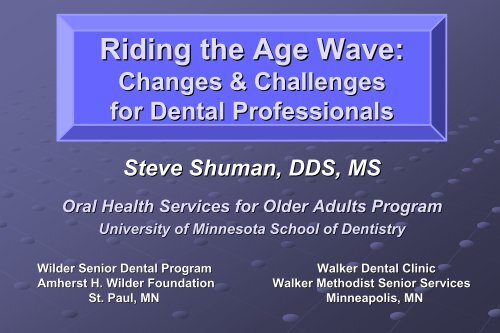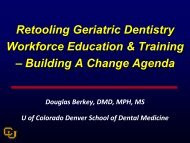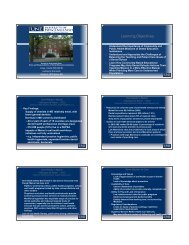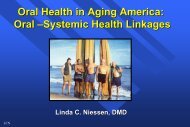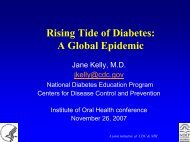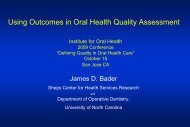Conference PPT (6 MB) - Institute for Oral Health
Conference PPT (6 MB) - Institute for Oral Health
Conference PPT (6 MB) - Institute for Oral Health
- No tags were found...
Create successful ePaper yourself
Turn your PDF publications into a flip-book with our unique Google optimized e-Paper software.
Riding the Age Wave:Changes & Challenges<strong>for</strong> Dental ProfessionalsSteve Shuman, DDS, MS<strong>Oral</strong> <strong>Health</strong> Services <strong>for</strong> Older Adults ProgramUniversity of Minnesota School of DentistryWilder Senior Dental ProgramWalker Dental ClinicAmherst H. Wilder Foundation Walker Methodist Senior ServicesSt. Paul, MNMinneapolis, MN
<strong>Oral</strong> <strong>Health</strong> Services<strong>for</strong> Older Adults ProgramUniversity of Minnesota School of Dentistry
“A good hockeyplayer playswhere the puck is.A great hockeyplayer playswhere the puck isgoing to be.”-WayneGretzky
Changes & ChallengesDemographic Trends<strong>Health</strong> & FunctionalStatus<strong>Oral</strong> <strong>Health</strong> IssuesUtilization & AccessChallenges &Recommendations
Demographic Trends
Demographic Trends
AgeU.S. Life ExpectancyTotalMaleFemale0 77.8 75.2 80.420 58.8 56.2 61.240 39.9 37.6 41.960 22.5 20.8 24.070 15.1 13.7 16.280 9.1 8.2 9.890 5.0 4.4 5.2100 2.6 2.3 2.6(Source: CDC, NCHS Life Tables, 2004)
The Rural Age BoomProportion of rural older populationgrowing faster:1980 2000Rural 65+ 13% 17%Urban 65+ 11% 13%Source: Population Reference Bureau, 2003
Diversity
<strong>Health</strong> & Functional Status
<strong>Health</strong> & Functional StatusHeterogeneity
U.S. Dementia StatisticsAffects: 13% of 65+ population~50% of 85+ populationSocietal cost: $100 billion per yearMean lifetime cost/patient:$174,00070% of dementia patients at home50% of NH residents have dementia$600 million on research in FY02(Source: Alzheimer’s s Association, 2007)
Medication Use in US Older Adults14% of population consumes 36.5% of Rx’sAverage number of meds (Rx + OTC) up to 9 perolder adultUtilization trends:• 2000 utilization: 28.5 Rx’s s per year• Projected 2010 utilization: 38.5 Rx’s s per year• 45% increase in utilization since 1992• Projected 2010 utilization: 35% over 2000Adverse drug events in 20-54% of older adults(Source: US FDA, 2003)
Functional Status
The Spectrum of Long-term Care"Well""Frail"+--------------+------------------+--------------------->>Full Short-term Long-termfunction --------->incapacity ---------->incapacity------------------->IndependentNursing home
The Spectrum of Long-term Care"Well""Frail"+--------------+------------------+--------------------->>Full Short-term Long-termfunction --------->incapacity ---------->incapacity------------------->Independent Post/sub-acute care Home health care Nursing homeTransitional care Adult dayhealth Hospice careRehab. careBoard & careAssisted living
<strong>Oral</strong> <strong>Health</strong> Issues
The well elderly with some old problems . . .
Heterogeneity in oral status
Declining U.S. Edentulism60Edentulous6+ Teeth Missing5040Percent30201001999 2002 2004(Source: NOHSS: BRFSS 2004 at www.cdc.gov/nohss)
Coronal Caries
Coronal CariesRoot Caries
Root Caries Incidence2004 systematic review of studies on root caries inolder adults:• Overall root caries incidence = 23.7% per year• Overall root caries increment = 0.47 surfaces/year• Overall caries increment = 1.31 surfaces/year• Overall caries rates were comparable to children(Source: Griffin et. al., JDR 83: 634-638, 2004)
Periodontitis Trends: Age 60+40Prevalence•Slow progression during adulthood3530•Age itself not a major risk factorPercent2520151050NHANES III NHANES 99-00Black Hispanic White•Individual risk factors more critical•Some gingival recession, loss ofattachment, bone support expectedwith advancing age•Conservative management usuallyeffective(Source: Borrell, Burt & Taylor, JDR, 2005)
34,000 new casesdiagnosed eachyear; 8000 deaths7x higher riskin 65+ population75% in users oftobacco, alcohol, orboth<strong>Oral</strong> Cancer
DementiaConsequences•Poor oral hygiene•Lack of professional care•Lost/<strong>for</strong>gotten dentures•Poor cooperation <strong>for</strong>treatment
GeneralMedication Consequences• Dry mouth (caries,(mucositis, , denture problems, etc.)• Soft tissue pathology (yeast, ulcerations, hyperplasia, etc.)Local anesthetic• Lip-chewing (if cognitively impaired)• Cardiovascular problems• BleedingSedatives• Over-sedation, confusion/delirium, falls, aspirationAnticoagulants• Potential bleedingAnalgesics• NSAID’s: : fluid retention/CHF, GI ulcers• Narcotics: confusion, falls, constipationBisphosphonates• Potential osteonecrosis
Episode 863:Gidget Gets Osteoporosis
Bisphosphonate–associatedOsteonecrosis
Utilization Trends: Age 65+US 65+ Population US 1999 US 2002 US 2004Dental Visit? 62.7% 64.5% 66.1%Cleaning? 70.8% 72.1% 73.1%CariesExperience?NotreportedNotreportedNotreportedUntreated Decay?NotreportedNotreportedNotreported(Source: NOHSS: BRFSS 2004 at www.cdc.gov/nohss)
65+ Dental Care Utilization: 5 State DataYear65+Population(%)PatientVisits(%)ServicesProvided(%)PatientExpenditures(%)1988 14.8 16.4 13.6 18.0(Source: Meskin and Berg, JADA, 2000)
65+ Dental Care Utilization: 5 State DataYear65+Population(%)PatientVisits(%)ServicesProvided(%)PatientExpenditures(%)1988 14.8 16.4 13.6 18.01998 15.2 19.9 17.5 22.0Change +0.4% +3.5% +3.9% +4%(Source: Meskin and Berg, JADA, 2000)
Conclusions: 5 State DataOlder adults have a disproportionate andpositive impact on practice economicsReevaluate practice accessibility to older adults• Direct appeal to older adults vs. practice “aging”Increase understanding of needs & preferencesof older adults already in practices(Source: Meskin and Berg, JADA, 2000)
Dental Access <strong>for</strong> US 65+ PopulationCharacteristic Total % Urban % Rural %Insurance StatusUninsured67.666.172.1Private21.623.615.7Public7.17.07.6Type of UserRegular42.945.933.9Episodic49.447.355.5(Sources: NHIS, 1997 & 1998 and *NCHS, 2001)
Nursing Home UseAbout 5% of US 65+adults live in nursinghomes at any one time,BUT:43-50% of those 65+ willspend some time in aNH be<strong>for</strong>e death.(Source: Spillman & Lubitz, Med. Care, 2002 )
US Nursing Home StatisticsIn 2004:• US nursing homes: 16,100• Number of residents:1.5 million• Average size:107 bedsProjected <strong>for</strong> 2030:• Number of residents:• Beds needed:3 million2 million(Source: CDC, NNHS, 2004)
US NH’s s with Dental ContractsUS TotalFor ProfitNon-profit/otherChainIndependent10,100 (63%)6500 (66%)3500 (57%)5600 (64%)4500 (61%)(Source: NNHS, 2004)
NH Service UtilizationMedical ServicesNutritional ServicesSocial ServicesPhysical TherapyDental Care91%74%70%27%26%(Source: NNHS, 1999)
Where the Puck is Going to Be older adults “old-old” adults racial/ethnic diversityOlder adults with:• multiple chronic diseases• multiple medicationsOlder adults in long-term careOlder adults with more teethOlder adults with higher expectations & utilization• Full range of oral/dental pathology• Full range of services needed and expected on demand
Professional Challenges in an Aging SocietyEnsuring access to geriatric dental care:• Financing?• Trained work<strong>for</strong>ce?• Rural communities?• Culturally diverse elders?• Across the long-term care spectrum?Educating older adults?Educating other health professionals?Clinical treatment challenges:• Multiple chronic diseases, disabilities?• Dementia patients?• Polymedicated patients?• Root caries prevention and treatment?• <strong>Oral</strong> cancer prevention and treatment?• <strong>Oral</strong> health in long-term care?
Recommendations: Clinical CarePromote comprehensive geriatric care everywhere needed:• Rural communities• Culturally diverse communities• Across the long-term care spectrumPromote geriatric care that:• Respects heterogenous patient values and needs• Encourages preventionValue the care of more complex patients:• Multiple chronic diseases• Disabilities• Polymedication
Recommendations: Education & ResearchEducationSupport better geriatric dental education at all dental professional onal levelsSupport inter-professional linkages and educationContinue to educate older adults about importance of good oral health hResearchPromote development of evidence-based geriatric care guidelinesPromote research on key geriatric treatment challenges, such as:• Root caries• Dry mouth• Soft tissue pathology, especially oral cancer• Preventive care• Care of those with chronic disease, disability• Care of those in long-term care settings
ThankYou!Steve Shuman, DDS, MSshuma001@umn.edu612-626626-0158


